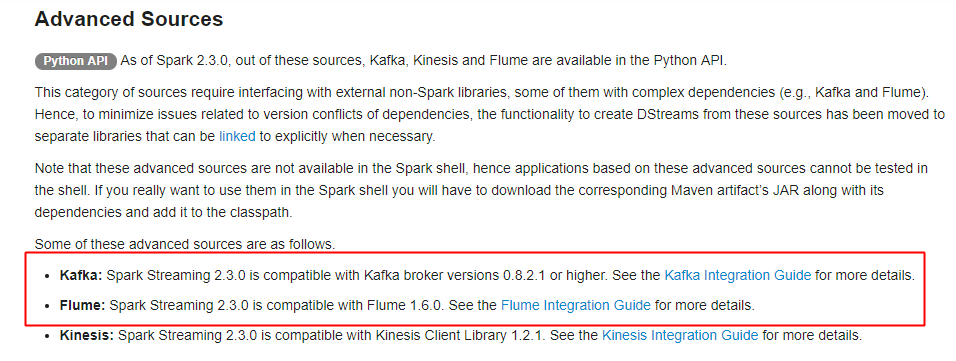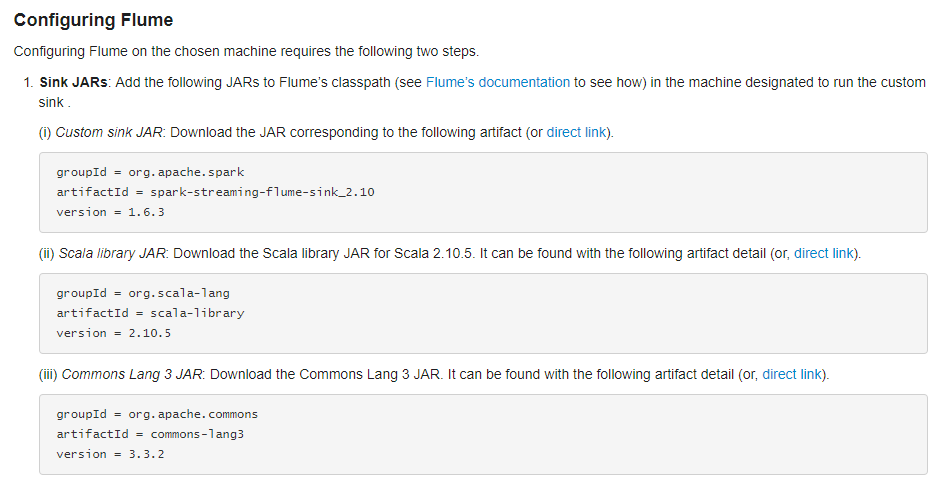大数据入门第二十四天——SparkStreaming(二)与flume、kafka整合
前一篇中数据源采用的是从一个socket中拿数据,有点属于“旁门左道”,正经的是从kafka等消息队列中拿数据!
主要支持的source,由官网得知如下:

获取数据的形式包括推送push和拉取pull
一、spark streaming整合flume
1.push的方式
更推荐的是pull的拉取方式
引入依赖:
<dependency>
<groupId>org.apache.spark</groupId>
<artifactId>spark-streaming-flume_2.10</artifactId>
<version>${spark.version}</version>
</dependency>
编写代码:
package com.streaming
import org.apache.spark.SparkConf
import org.apache.spark.streaming.flume.FlumeUtils
import org.apache.spark.streaming.{Seconds, StreamingContext}
/**
* Created by ZX on 2015/6/22.
*/
object FlumePushWordCount {
def main(args: Array[String]) {
val host = args(0)
val port = args(1).toInt
val conf = new SparkConf().setAppName("FlumeWordCount")//.setMaster("local[2]")
// 使用此构造器将可以省略sc,由构造器构建
val ssc = new StreamingContext(conf, Seconds(5))
// 推送方式: flume向spark发送数据(注意这里的host和Port是streaming的地址和端口,让别人发送到这个地址)
val flumeStream = FlumeUtils.createStream(ssc, host, port)
// flume中的数据通过event.getBody()才能拿到真正的内容
val words = flumeStream.flatMap(x => new String(x.event.getBody().array()).split(" ")).map((_, 1))
val results = words.reduceByKey(_ + _)
results.print()
ssc.start()
ssc.awaitTermination()
}
}
flume-push.conf——flume端配置文件:

# Name the components on this agent a1.sources = r1 a1.sinks = k1 a1.channels = c1 # source a1.sources.r1.type = spooldir a1.sources.r1.spoolDir = /export/data/flume a1.sources.r1.fileHeader = true # Describe the sink a1.sinks.k1.type = avro #这是接收方 a1.sinks.k1.hostname = 192.168.31.172 a1.sinks.k1.port = 8888 # Use a channel which buffers events in memory a1.channels.c1.type = memory a1.channels.c1.capacity = 1000 a1.channels.c1.transactionCapacity = 100 # Bind the source and sink to the channel a1.sources.r1.channels = c1 a1.sinks.k1.channel = c1
2.pull的方式
属于推荐的方式,通过streaming来主动拉取flume产生的数据
编写代码:(依赖同上)
package com.streaming
import java.net.InetSocketAddress
import org.apache.spark.SparkConf
import org.apache.spark.storage.StorageLevel
import org.apache.spark.streaming.flume.FlumeUtils
import org.apache.spark.streaming.{Seconds, StreamingContext}
object FlumePollWordCount {
def main(args: Array[String]) {
val conf = new SparkConf().setAppName("FlumePollWordCount").setMaster("local[2]")
val ssc = new StreamingContext(conf, Seconds(5))
//从flume中拉取数据(flume的地址),通过Seq序列,里面可以new多个地址,从多个flume地址拉取
val address = Seq(new InetSocketAddress("172.16.0.11", 8888))
val flumeStream = FlumeUtils.createPollingStream(ssc, address, StorageLevel.MEMORY_AND_DISK)
val words = flumeStream.flatMap(x => new String(x.event.getBody().array()).split(" ")).map((_,1))
val results = words.reduceByKey(_+_)
results.print()
ssc.start()
ssc.awaitTermination()
}
}
配置flume
通过拉取的方式需要flume的lib目录中有相关的JAR(要通过spark程序来调flume拉取),通过官网可以得知具体的JAR信息:

配置flume:

# Name the components on this agent a1.sources = r1 a1.sinks = k1 a1.channels = c1 # source a1.sources.r1.type = spooldir a1.sources.r1.spoolDir = /export/data/flume a1.sources.r1.fileHeader = true # Describe the sink(配置的是flume的地址,等待拉取) a1.sinks.k1.type = org.apache.spark.streaming.flume.sink.SparkSink a1.sinks.k1.hostname = mini1 a1.sinks.k1.port = 8888 # Use a channel which buffers events in memory a1.channels.c1.type = memory a1.channels.c1.capacity = 1000 a1.channels.c1.transactionCapacity = 100 # Bind the source and sink to the channel a1.sources.r1.channels = c1 a1.sinks.k1.channel = c1
启动flume,然后启动IDEA中的spark streaming:
bin/flume-ng agent -c conf -f conf/netcat-logger.conf -n a1 -Dflume.root.logger=INFO,console
// -D后参数可选
二、spark streaming整合kafka
前导知识,复习kafka:http://www.cnblogs.com/jiangbei/p/8537625.html
1.引入依赖
<dependency>
<groupId>org.apache.spark</groupId>
<artifactId>spark-streaming-kafka_2.10</artifactId>
<version>${spark.version}</version>
</dependency>
2.编写代码
package com.streaming
import org.apache.spark.{HashPartitioner, SparkConf}
import org.apache.spark.storage.StorageLevel
import org.apache.spark.streaming.kafka.KafkaUtils
import org.apache.spark.streaming.{Seconds, StreamingContext}
object KafkaWordCount {
val updateFunc = (iter: Iterator[(String, Seq[Int], Option[Int])]) => {
//iter.flatMap(it=>Some(it._2.sum + it._3.getOrElse(0)).map(x=>(it._1,x)))
iter.flatMap { case (x, y, z) => Some(y.sum + z.getOrElse(0)).map(i => (x, i)) }
}
def main(args: Array[String]): Unit = {
val Array(zkQuorum, group, topics, numThreads) = args
val conf = new SparkConf().setAppName("kafkaWordCount").setMaster("local[2]")
val ssc = new StreamingContext(conf, Seconds(5))
// 设置ck
ssc.checkpoint("F:/ck")
// 产生topic的map
val topicMap = topics.split(",").map((_, numThreads.toInt)).toMap
// data是一个DStream
val data = KafkaUtils.createStream(ssc, zkQuorum, group, topicMap, StorageLevel.MEMORY_AND_DISK_SER)
val words = data.map(_._2).flatMap(_.split(" "))
// 使用update进行累加统计
val wordCounts = words.map((_, 1)).updateStateByKey(updateFunc, new HashPartitioner(ssc.sparkContext.defaultParallelism), true)
// 启动
ssc.start()
ssc.awaitTermination()
}
}
结合kafka也是存在两种拉取数据的形式,包括Receiver和Direct两种形式
更多参考:https://www.cnblogs.com/xlturing/p/6246538.html
但是使用更多的是Direct的直连方式,因为直连方式使用的不需要记录日志,不会影响性能
使用实例,参考:https://blog.csdn.net/ligt0610/article/details/47311771



 浙公网安备 33010602011771号
浙公网安备 33010602011771号